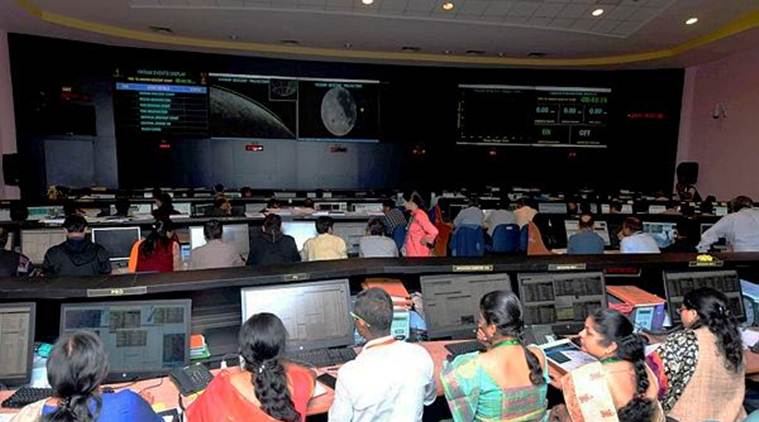- India
- International
‘India’s attempt highlighted its engineering prowess’: Global media on Chandrayaan-2 setback
From The New York Times to the Guardian, here's how international media reported on Chandrayaan-2's setback.
 Officials watch live telecast of Chandrayaan 2 at ISRO Telemetry Tracking and Command Network (ISTRAC) prior to the soft landing of Vikram module of Chandrayaan 2 on the lunar surface, in Bengaluru, Saturday. (Photo: Twitter/PTI)
Officials watch live telecast of Chandrayaan 2 at ISRO Telemetry Tracking and Command Network (ISTRAC) prior to the soft landing of Vikram module of Chandrayaan 2 on the lunar surface, in Bengaluru, Saturday. (Photo: Twitter/PTI)
India’s hopes to touch the Moon’s surface appeared to have dashed on Saturday after the Indian Space Research Organisation (ISRO) lost contact with the Chandrayaan-2 lander Vikram just 13 minutes after it began its final descent to land on the lunar surface.
Prime Minister Narendra Modi, who had joined the scientists 15 minutes before the descent began at 1.38 am on Saturday night, was briefed by a glum-looking ISRO chairman K Sivan, and other senior officials. “Be courageous,” said the Prime Minister to the dejected scientists after ISRO chief K Sivan announced that contact with the lander had been lost at an altitude of 2.1 km from the moon’s surface. Chandrayaan-2 was India’s first attempt at landing a spacecraft on the moon. Only three countries — the United States, the erstwhile USSR and China — have managed to place a spacecraft on Moon so far. Follow Chandrayaan-2 LIVE Updates
Here’s how international media covered India’s Moon mission
The New York Times: On the failure of Vikram to land on the Moon’s south pole, the NYT wrote, “While India may not have stuck the landing on its first try, its attempt highlighted how its engineering prowess and decades of space development have combined with its global ambitions.”
It also raised speculations about how this “crash” could impact the national politics of the country led by “nationalist leader” Modi. “It remains to be seen what the crash will mean in India’s domestic politics. Prime Minister Narendra Modi, the country’s nationalist leader, has embraced the country’s space program to raise India’s brand on the global stage and make Indians feel fired up about their nation’s growing strength,” The NYT report said.
See photos | ISRO loses touch with Chandrayaan-2’s Vikram lander, PM says ‘effort was worth it’

It also threw light on the rising popularity of “Space” in India. “In some Indian cities, posters for Chandrayaan-2 have been plastered on giant billboards. Schoolchildren in space classes are launching rockets made from empty plastic soda bottles. In July, when India sent up the rocket carrying the lander, millions watched the live broadcasts of the rocket cutting into the sky on top of a funnel of fire,” it observed.
The Guardian: The UK-based news outlet described the Chandrayaan-2 Mission as India’s “most complex and ambitious space project”. It said, “the mission, which comes amid a renewed global interest in moon exploration, was watched closely by scientists around. It is hoped the rover, named Pragyan, which means “wisdom” in Sanskrit, would spend two weeks collecting crucial data about the composition of the moon’s surface.”
“It is due to explore craters which contain a fossil record of the early solar system, for clues on the origin and evolution of the Moon. It is also hoped Pragyan, a six-wheeled vehicle, could help scientists understand how much water the polar region contains,” it said. The Guardian also quoted Mathieu Weiss, a representative in India for France’s space agency CNES, as saying, “India is going where probably the future settlements of humans will be in 20 years, in 50 years, 100 years.”
Explained | ISRO’s Vikram Lander is lost, but this hardly matters. Here’s why
The BBC said the Chandrayaan mission made global headlines because it was “so cheap”. “The budget for Avengers: Endgame, for instance, was more than double at an estimated USD 356 million. But this isn’t the first time ISRO has been hailed for its thrift. Its 2014 Mars mission cost USD 74 million, a tenth of the budget for the American Maven orbiter,” it said.
The Washington Post, in its headline “India’s first attempt to land on the moon appears to have failed”, said the mission had been a source of “immense national pride”.
“Social media erupted in support of the space agency and its scientists despite the setback… The incident could now set back India’s growing space ambitions, seen as a reflection of the aspirations of its young population,” it said.
The Moscow-based RT said with India’s failure to make its lander touch the Moon’s surface, the Moon Club remains exclusive. “With India’s failure to deliver the lander to the surface gently enough, the Moon Club remains fairly exclusive. Only the former Soviet Union, the US and China have successfully landed a man-made device on the Earth’s satellite so far.”
New Zealand’s Stuff.co.nz said a successful landing of Vikram would have placed India at fourth on landing a vessel on the Moon’s surface. “The fate of the lander, whether it crashed or landed, wasn’t immediately known. A successful landing would have made India just the fourth country to land a vessel on the lunar surface, and only the third nation to operate a robotic rover there,” it wrote.
Describing the ISRO’s space station at the time when Vikram started its descent till its contact was lost, the media reported, “The entire control centre was jubilant during the first 10 minutes of lander’s descent, with scientists breaking out in occasional cheers. The mood suddenly turned somber and then dejected when the lander stopped sending data during its final minutes of descent.”
Apr 19: Latest News
- 01
- 02
- 03
- 04
- 05





























